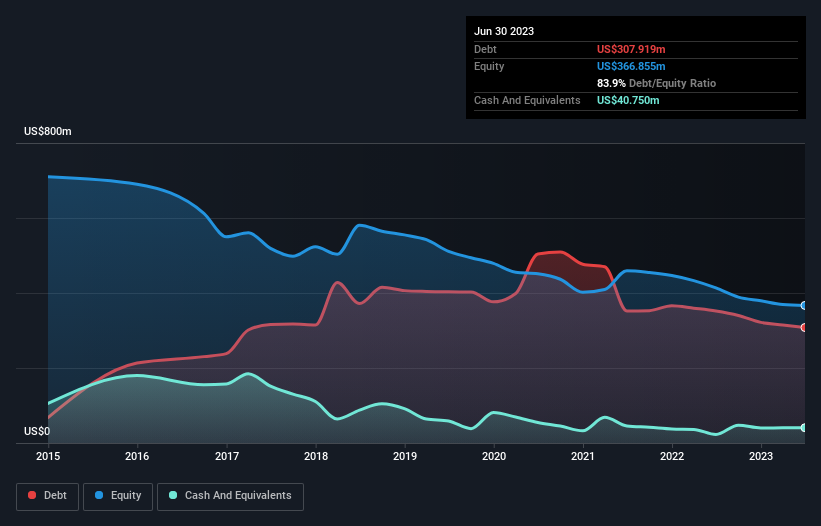- United States
- /
- Energy Services
- /
- NYSE:SMHI
Here's Why SEACOR Marine Holdings (NYSE:SMHI) Can Afford Some Debt

Warren Buffett famously said, 'Volatility is far from synonymous with risk.' It's only natural to consider a company's balance sheet when you examine how risky it is, since debt is often involved when a business collapses. We can see that SEACOR Marine Holdings Inc. (NYSE:SMHI) does use debt in its business. But the real question is whether this debt is making the company risky.
When Is Debt A Problem?
Generally speaking, debt only becomes a real problem when a company can't easily pay it off, either by raising capital or with its own cash flow. Part and parcel of capitalism is the process of 'creative destruction' where failed businesses are mercilessly liquidated by their bankers. While that is not too common, we often do see indebted companies permanently diluting shareholders because lenders force them to raise capital at a distressed price. By replacing dilution, though, debt can be an extremely good tool for businesses that need capital to invest in growth at high rates of return. The first thing to do when considering how much debt a business uses is to look at its cash and debt together.
Check out our latest analysis for SEACOR Marine Holdings
How Much Debt Does SEACOR Marine Holdings Carry?
The image below, which you can click on for greater detail, shows that SEACOR Marine Holdings had debt of US$307.9m at the end of June 2023, a reduction from US$352.1m over a year. However, it does have US$40.8m in cash offsetting this, leading to net debt of about US$267.2m.

A Look At SEACOR Marine Holdings' Liabilities
According to the last reported balance sheet, SEACOR Marine Holdings had liabilities of US$126.7m due within 12 months, and liabilities of US$290.7m due beyond 12 months. Offsetting these obligations, it had cash of US$40.8m as well as receivables valued at US$77.8m due within 12 months. So its liabilities total US$298.8m more than the combination of its cash and short-term receivables.
This is a mountain of leverage relative to its market capitalization of US$412.6m. Should its lenders demand that it shore up the balance sheet, shareholders would likely face severe dilution. There's no doubt that we learn most about debt from the balance sheet. But it is SEACOR Marine Holdings's earnings that will influence how the balance sheet holds up in the future. So when considering debt, it's definitely worth looking at the earnings trend. Click here for an interactive snapshot.
Over 12 months, SEACOR Marine Holdings reported revenue of US$245m, which is a gain of 28%, although it did not report any earnings before interest and tax. Shareholders probably have their fingers crossed that it can grow its way to profits.
Caveat Emptor
Even though SEACOR Marine Holdings managed to grow its top line quite deftly, the cold hard truth is that it is losing money on the EBIT line. Indeed, it lost US$21m at the EBIT level. Considering that alongside the liabilities mentioned above does not give us much confidence that company should be using so much debt. Quite frankly we think the balance sheet is far from match-fit, although it could be improved with time. Another cause for caution is that is bled US$7.1m in negative free cash flow over the last twelve months. So suffice it to say we do consider the stock to be risky. For riskier companies like SEACOR Marine Holdings I always like to keep an eye on whether insiders are buying or selling. So click here if you want to find out for yourself.
When all is said and done, sometimes its easier to focus on companies that don't even need debt. Readers can access a list of growth stocks with zero net debt 100% free, right now.
New: Manage All Your Stock Portfolios in One Place
We've created the ultimate portfolio companion for stock investors, and it's free.
• Connect an unlimited number of Portfolios and see your total in one currency
• Be alerted to new Warning Signs or Risks via email or mobile
• Track the Fair Value of your stocks
Have feedback on this article? Concerned about the content? Get in touch with us directly. Alternatively, email editorial-team (at) simplywallst.com.
This article by Simply Wall St is general in nature. We provide commentary based on historical data and analyst forecasts only using an unbiased methodology and our articles are not intended to be financial advice. It does not constitute a recommendation to buy or sell any stock, and does not take account of your objectives, or your financial situation. We aim to bring you long-term focused analysis driven by fundamental data. Note that our analysis may not factor in the latest price-sensitive company announcements or qualitative material. Simply Wall St has no position in any stocks mentioned.
About NYSE:SMHI
SEACOR Marine Holdings
Provides marine and support transportation services to offshore oil, natural gas, and windfarm facilities in the United States, Africa, Europe, the Middle East, Asia, and Latin America.
Mediocre balance sheet and slightly overvalued.
Similar Companies
Market Insights
Community Narratives



